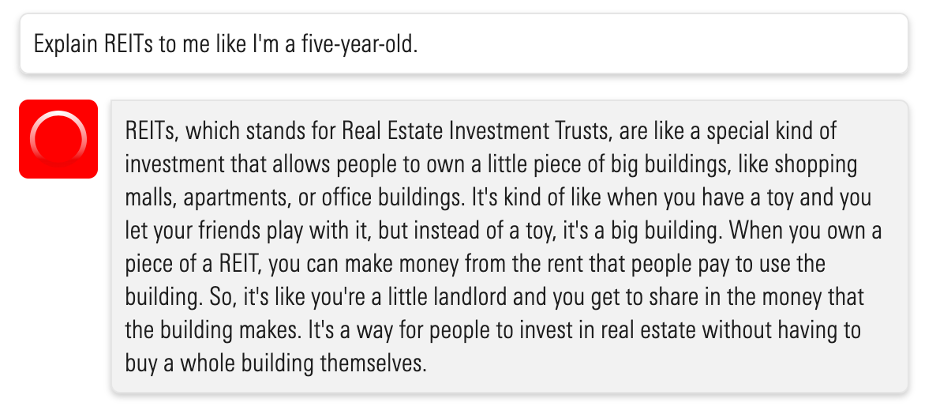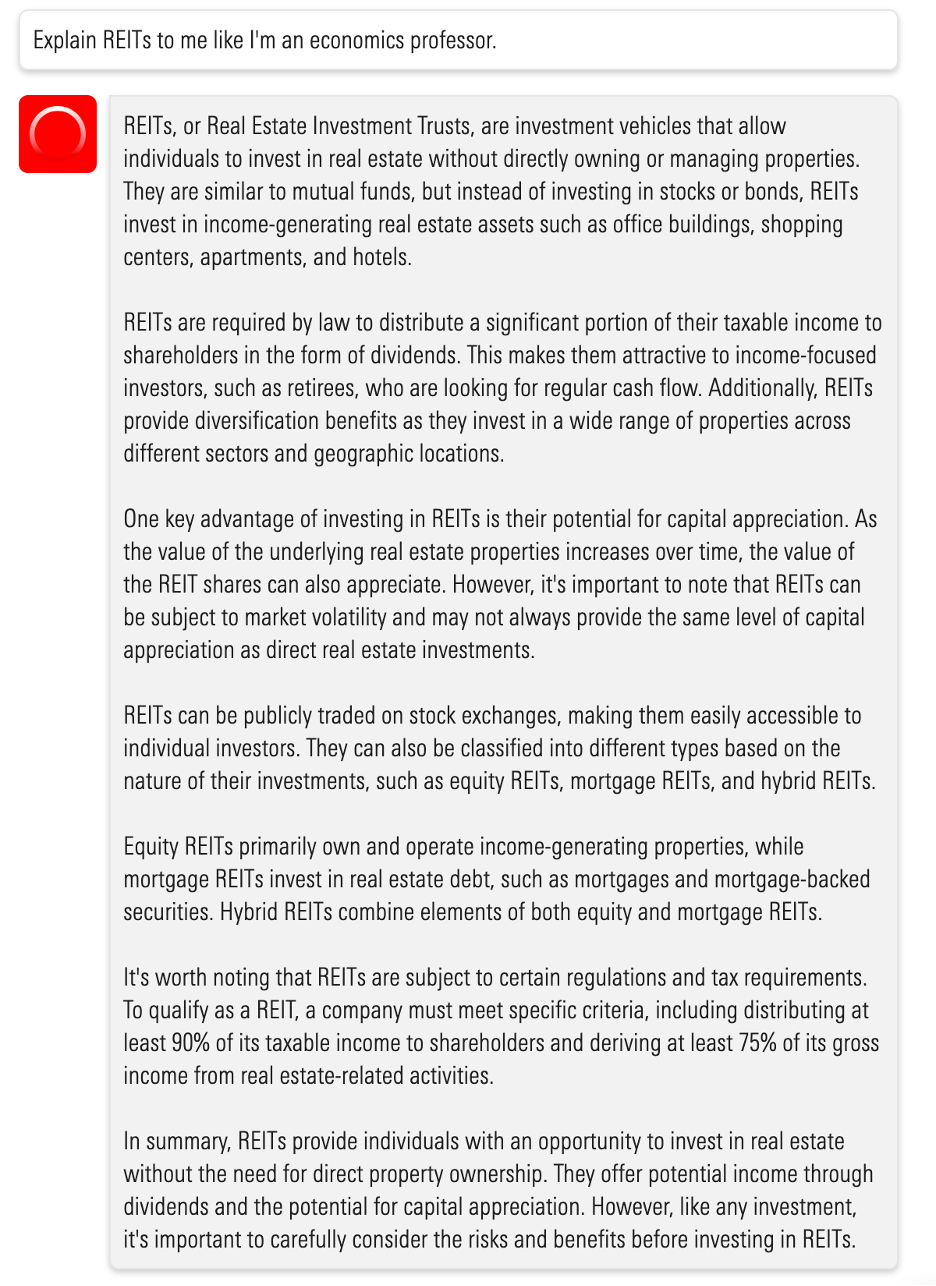4 min read
How to Improve Client Conversations With AI for Financial Advisors
Here’s how financial advisors can fine-tune communication with generative artificial intelligence.

We often warn advisors against using jargon with their clients, as doing so can turn clients off of working with them.
However, technical concepts will come up with clients sometimes; it’s inevitable. So how exactly can an advisor strike the balance between explaining them too much or too little?
Here’s where generative AI can come in handy.
How Advisors Use Artificial Intelligence
In the financial services industry, artificial intelligence has sparked enthusiasm with its promise to automate tedious tasks and accelerate complicated ones. Wealth management firms are experimenting with AI in sales, marketing, and customer service.
Generative AI can write in different tones, reading levels, and contexts, making it a useful tool for improving your client communication—tool being the operative word.
The AI’s output should be taken as a starting point and not as an end point for a couple of reasons:
- It may be inaccurate. AI is prone to “hallucinations”—instances where it will provide false information—so it should always be reviewed by a human expert (that’s you).
- Your voice is essential. Unless you’ve taken the time to train the AI on the body of your work, it cannot speak in your unique voice that resonates with your clients and cannot access the important insights you’ve gained through client relationships.
We created the following exercise to combine the power of generative AI with your strengths as a financial advisor to craft better explanations for your clients.
For more tips on how to talk about alternative investments and complex products with clients, download the trendy asset classes report.
1. Create a starting point using a generative AI tool.
Prompt the AI to give you an explanation for a financial concept twice: once at a level too simple for your clients and once at a level too complex for your clients’ purposes.
We used Mo, an AI chatbot built on the Morningstar Intelligence engine. Mo is designed to surface and summarize Morningstar’s independent insights in an easy-to-digest way.


First, we prompted Mo to explain REITs as though we were five years old.
Here’s what the chatbot said:
REITs, which stands for Real Estate Investment Trusts, are like a special kind of investment that allows people to own a little piece of big buildings, like shopping malls, apartments, or office buildings.
It’s kind of like when you have a toy and you let your friends play with it, but instead of a toy, it’s a big building. When you own a piece of a REIT, you can make money from the rent that people pay to use the building. So it’s like you’re a little landlord and you get to share in the money that the building makes. It’s a way for people to invest in real estate without having to buy a whole building themselves.
Then we prompted Mo to explain REITs to an economics professor.
Here’s what we saw:
REITs, or Real Estate Investment Trusts, are investment vehicles that allow individuals to invest in real estate without directly owning or managing properties. They are similar to mutual funds, but instead of investing in stocks or bonds, REITs invest in income-generating real estate assets such as office buildings, shopping centers, apartments, and hotels.
REITs are required by law to distribute a significant portion of their taxable income to shareholders in the form of dividends. This makes them attractive to income-focused investors, such as retirees, who are looking for regular cash flow. Additionally, REITs provide diversification benefits as they invest in a wide range of properties across different sectors and geographic locations.
One key advantage of investing in REITs is their potential for capital appreciation. As the value of the underlying real estate properties increases over time, the value of the REIT shares can also appreciate. However, it's important to note that REITs can be subject to market volatility and may not always provide the same level of capital appreciation as direct real estate investments.
REITs can be publicly traded on stock exchanges, making them easily accessible to individual investors. They can also be classified into different types based on the nature of their investments, such as equity REITs, mortgage REITs, and hybrid REITs.
Equity REITs primarily own and operate income-generating properties, while mortgage REITs invest in real estate debt, such as mortgages and mortgage-backed securities. Hybrid REITs combine elements of both equity and mortgage REITs.
It’s worth noting that REITs are subject to certain regulations and tax requirements. To qualify as a REIT, a company must meet specific criteria, including distributing at least 90% of its taxable income to shareholders and deriving at least 75% of its gross income from real estate-related activities.
In summary, REITs provide individuals with an opportunity to invest in real estate without the need for direct property ownership. They offer potential income through dividends and the potential for capital appreciation. However, like any investment, it's important to carefully consider the risks and benefits before investing in REITs.
2. Check the AI responses for accuracy.
Read through the responses and ensure the AI has not had any hallucinations. This is an opportunity to brush up on your knowledge of the topic as well. Morningstar’s investment research and planning tools include data on alternative investments, structured products, and other emerging asset classes and can be a useful resource for ensuring the AI is accurate.
3. Identify the strengths and weaknesses of both AI explanations.
Some strengths of the simple explanation are its succinctness and the use of a simile to illustrate the concept in a tangible way. However, the language it uses may be too immature for clients given that it was written for a child.
Some strengths of the complex explanation include identifying different beneficial factors of REITs, such as their diversification and dividends. However, it provides more detail than your clients will likely need (or want) about such factors.
4. Fill in the gaps with your experience.
Start by identifying components missing from the explanations, like phrases you have found that are particularly effective or any details Mo may have left out. Then, write a few sentences that incorporate client-dependent context, such as how it fits into their financial goals and their risk tolerance.
Connecting your messaging to a client’s unique situation can help them resonate more with your explanation and may prompt them to follow your financial advice.
5. Craft your message.
Write your own explanation by combining the strengths identified in Step 3, the gaps identified in Step 4, and your own voice—after all, your clients chose you for a reason.
New, disruptive technologies won't replace advisors, but they will become tools for your to work faster, more effectively, or more efficiently.
In the end, your message should sound a lot like you than Mo, but the insights you gained from using a generative AI tool will ensure you’ve created client-friendly explanations of complex financial topics.
What Do Investors Think About Advisors Leveraging Generative AI?
Financial advisors continue to face a rising demand to scale their business while maintaining a personal touch with clients. By learning how to integrate generative AI in a way that improves both workflow and relationships, it can be easier for advisors to save time and deliver valuable advice.
But what are investors’ reactions to advisors incorporating generative AI into their practice? Our latest research finds that the answer depends on what, how, and why advisors are using the powerful tool.
Key questions to consider include:
What tasks are you completing with generative AI? Turning to generative AI in place of personal connection may have a negative impact on relationships. Instead, implement the tool to facilitate human interaction—such as helping you and your clients brainstorm financial goals together. Clients may also have privacy concerns, so it’s important to be clear about the measures you’re taking to protect their data.
How is the usage of generative AI being implemented in your practice? To address fears investors could have on generative AI in financial advice, advisors must implement precautions and have open conversations to discuss any hesitations. Investors may overall be more receptive to generative AI if an advisor is honest and responsible in how they plan to leverage the tool in their workflow.
Why are you using generative AI in this manner? Many investors are aware that generative AI could be used to cut corners and possibly result in lower-quality work than what a human expert can achieve. Advisors need to explain to clients that this tool allows them to do some parts of their job more efficiently, thus freeing up time to better help clients.
